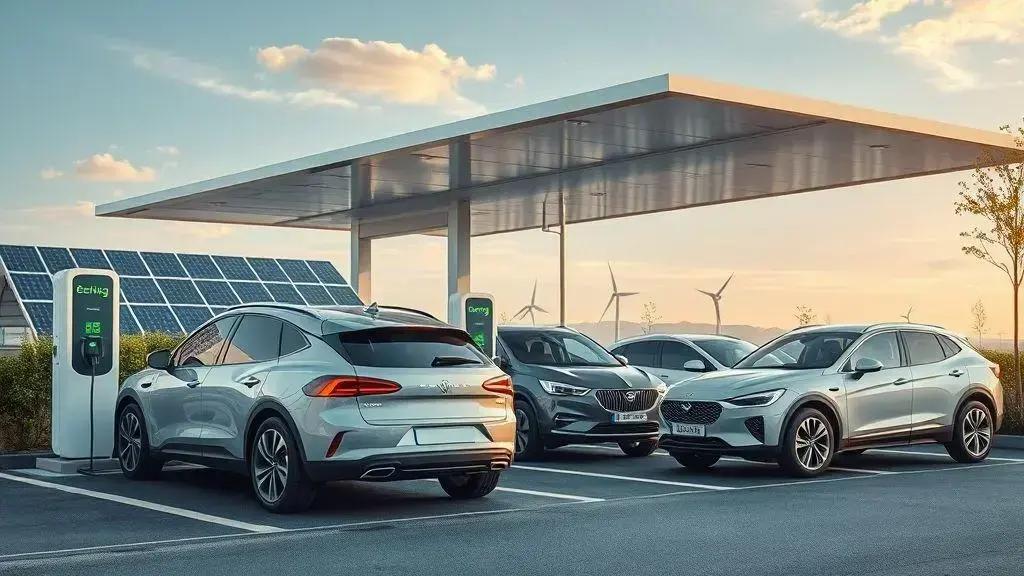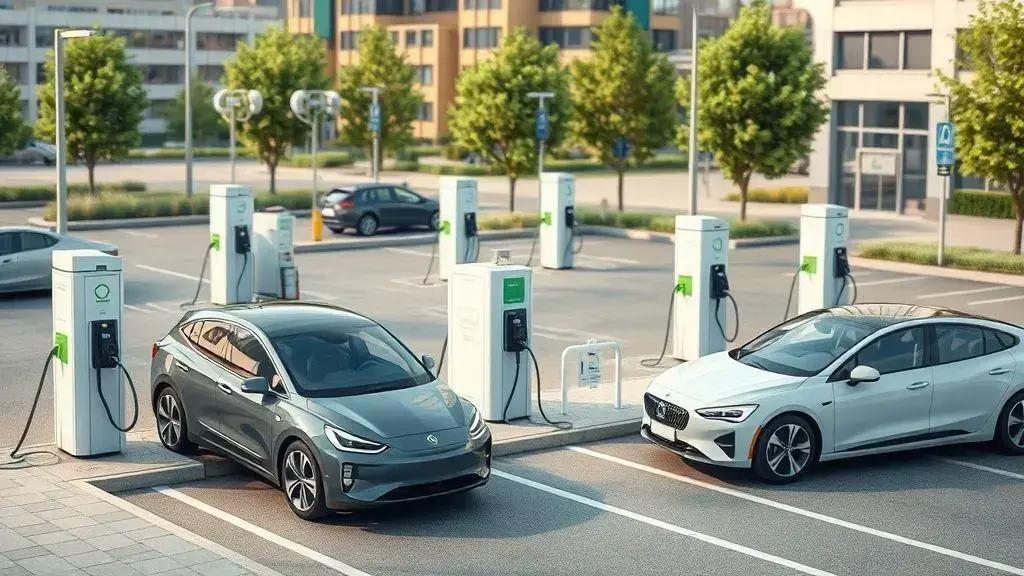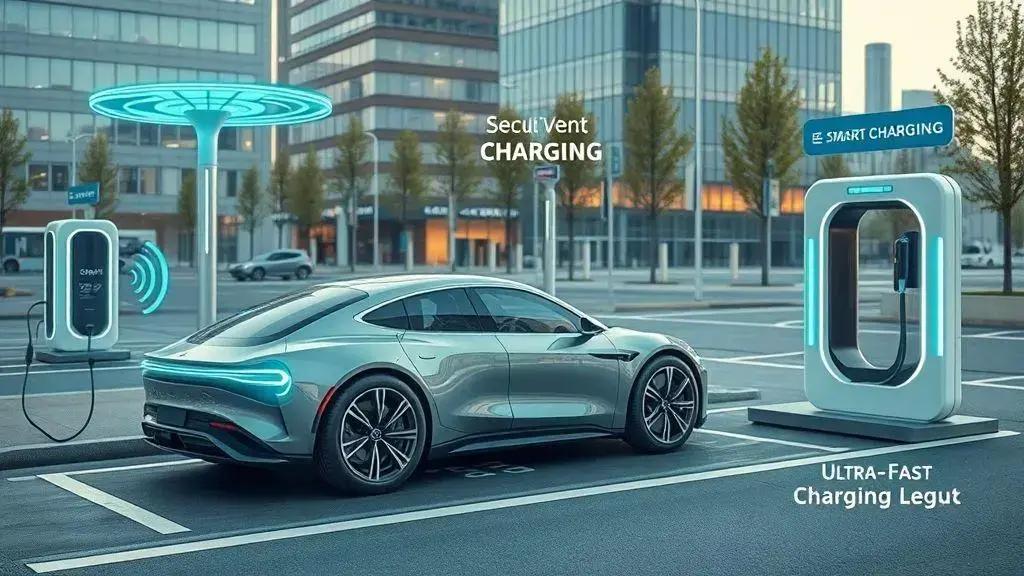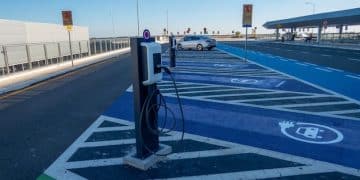New charging infrastructure for electric vehicles: what to expect

The development of new charging infrastructure for electric vehicles is crucial for enhancing accessibility, reducing charging times, and supporting widespread adoption, while addressing challenges such as energy demand and public awareness.
The emergence of new charging infrastructure for electric vehicles is reshaping our approach to transportation. Have you considered how this will affect your daily commute or travel plans? Let’s dive into this evolving landscape.
Understanding the basics of electric vehicle charging
Understanding the basics of electric vehicle charging is crucial for anyone considering the switch to electric mobility. With the rise of electric vehicles (EVs), it’s essential to grasp how charging works and the various options available.
Types of Electric Vehicle Chargers
Electric vehicle chargers come in different types, which cater to various needs and situations.
- Level 1 Chargers: These are standard household outlets. They are the slowest charging option, perfect for overnight charging at home.
- Level 2 Chargers: These require a dedicated charging unit and can be installed at home or found in public areas. They charge vehicles much faster than Level 1.
- DC Fast Chargers: Ideal for quick charging, these high-powered chargers can add significant range in just a short period. They’re often found along highways for long-distance travel.
Understanding these types can save you time and enhance your EV experience. Additionally, knowing where to find charging stations is part of the journey.
Charging Locations
Charging locations are an essential aspect of owning an EV. You will find charging stations in various places:
- Home: Installing a Level 2 charger at home can provide peace of mind, allowing you to charge while you sleep.
- Work: Many companies are installing chargers to support their employees who drive electric vehicles.
- Public Charging Stations: Grocery stores, shopping malls, and parking garages increasingly offer charging options. Apps can help locate nearby chargers.
Charging your EV at home is often the most convenient solution, but public charging offers flexibility for longer trips. It’s also important to understand how charging time affects your daily routine.
Charging Time and Efficiency
Charging times vary depending on the charger type, but planning can make the process more efficient. With Level 1 chargers, it may take up to 24 hours to fully charge a dead battery, while Level 2 charges can typically recharge an EV in 4-8 hours. Meanwhile, DC Fast Chargers can provide an 80% charge in under an hour. This variability allows you to choose the most suitable option for your lifestyle.
By understanding these basics of electric vehicle charging, you’ll feel more confident navigating your EV ownership. Knowledge empowers you to make better decisions and ensure a smoother transition to driving electric.
Benefits of improved charging infrastructure

The benefits of improved charging infrastructure for electric vehicles are significant and impactful. As more people transition to electric cars, having robust infrastructure supports this shift.
Enhanced Accessibility
One of the primary advantages is enhanced accessibility. With more charging stations available, drivers can easily find a place to charge without anxiety. This wide availability encourages more people to consider electric vehicles.
- Convenience: Charging stations are often located in popular places like shopping centers, making it easy to charge while you shop.
- Range Confidence: Knowing that chargers are readily available helps reduce the fear of running out of battery.
- Home Charging: Improved infrastructure includes options for home charger installation, providing flexibility and ease.
Increased accessibility empowers consumers and helps drive the adoption of electric vehicles. Furthermore, it contributes to a cleaner environment.
Environmental Benefits
Better charging infrastructure also has significant environmental advantages. The more people switch to electric vehicles, the more we reduce harmful emissions. Electric cars produce zero tailpipe emissions, which is a significant step toward a healthier planet.
Moreover, many charging stations are starting to use renewable energy sources like solar power. This shift not only supports the growth of electric mobility but also aligns with global efforts to combat climate change. When combined with cleaner electricity generation, the benefits multiply.
Enhanced charging options lead to increased adoption. As consumers see these benefits, they are more likely to choose electric vehicles over traditional gas-powered cars.
Investing in charging infrastructure is not just about building stations; it is about creating a sustainable future. The network of chargers will allow people to make the switch more comfortably.
Challenges in developing charging networks
The challenges in developing charging networks for electric vehicles are multifaceted and need addressing to support the growing demand. As the popularity of electric vehicles rises, so does the need for a robust charging infrastructure.
Infrastructure Limitations
Many areas face significant limitations in existing infrastructure. Urban environments may struggle with space for new charging stations. This can hinder installation and availability.
- High Costs: Building new charging stations can be expensive, especially in densely populated areas where space is tight.
- Power Supply: Not all locations have the sufficient power supply for fast chargers, complicating deployment.
- Permitting Issues: Regulatory processes can delay charging station installations, which slows down progress.
These infrastructural limitations can slow the rollout of charging networks, impacting EV adoption rates. Moreover, there’s the challenge of creating a sustainable energy source.
Energy Demand
As more electric vehicles hit the roads, the demand for electrical energy increases. Utilities must ensure they can meet this need without overloading the grid. That’s why renewable energy sources are crucial to this transition.
Finding a balance between demand and supply is essential. Increased energy consumption can strain existing grids. Additionally, if reliance on non-renewable energy sources continues, it defeats the purpose of switching to electric vehicles in the first place.
Providing adequate energy for charging requires careful planning and innovation. Solutions may include integrating solar panels into charging stations or finding ways to store energy effectively.
Public Awareness and Adoption
Another challenge is public awareness. Many potential EV owners are still unaware of charging options and how they work. Educational initiatives are necessary to bridge this gap.
- Understanding Charging Options: Many individuals are not familiar with different charging levels and their benefits.
- Addressing Range Anxiety: Overcoming the fear of running out of charge while traveling requires effective communication about charging networks.
- Incentives: Providing incentives for both consumers and businesses to install charging stations can drive development.
Improving public awareness can lead to increased acceptance of electric vehicles. Addressing these challenges holistically is crucial for developing effective charging networks.
Future trends in electric vehicle charging technology

The future trends in electric vehicle charging technology promise exciting advancements that can shape how we use electric vehicles. As demand for EVs grows, innovation in charging technology is essential.
Wireless Charging
One emerging trend is wireless charging. This technology allows electric vehicles to charge without plugging in. Imagine simply parking your car over a charging pad, and the energy transfers automatically.
- Convenience: No more dealing with cables or connectors.
- Efficiency: Charging can occur during parking, such as at shopping centers or workplaces.
- Safety: Reduces wear and tear on physical connectors, leading to less maintenance.
Wireless charging represents a significant leap in user-friendly technology, making electric vehicles more accessible.
Smart Charging Solutions
Smart charging is another critical trend. This involves using technology to optimize when and how vehicles charge. Smart chargers can communicate with the grid, adjusting charging times based on electricity demand and rates.
Savings can be substantial. For example, charging during off-peak hours can reduce costs. Additionally, these systems can provide energy back to the grid, helping balance energy usage. This two-way communication is reshaping how we think about energy consumption.
Fast Charging Advances
Advancements in fast charging technology are also on the horizon. New fast chargers are being developed that can significantly reduce charging time.
- Ultra-Fast Chargers: These can charge a vehicle to 80% in under 20 minutes, making long trips more feasible.
- Battery Technology: Improved battery chemistry and management can enhance charging speeds and efficiency.
- Expanded Network: As fast chargers become more widespread, long-distance travel with EVs will become increasingly practical.
These developments will make electric vehicles even more attractive options for consumers. With ongoing research and innovation, the future looks bright for charging technology.
In conclusion, the development of charging infrastructure for electric vehicles is vital for promoting sustainable transportation. As we embrace new technologies like wireless charging, smart systems, and faster charging solutions, the electric vehicle landscape will become even more user-friendly and accessible. Addressing the challenges of infrastructure limitations and energy demand will ensure that we can adequately support the growing number of electric vehicles on the road. It’s an exciting time as we work towards a greener future!
FAQ – Frequently Asked Questions about Electric Vehicle Charging Infrastructure
What are the advantages of improved charging infrastructure?
Improved charging infrastructure enhances accessibility, reduces range anxiety, and promotes the widespread adoption of electric vehicles.
How fast can electric vehicle charging become?
With advancements in technology, new fast chargers can provide an 80% charge in under 20 minutes, significantly reducing wait times.
What is smart charging?
Smart charging uses technology to optimize charging times and energy use, allowing electric vehicles to charge during off-peak hours and save costs.
Are there challenges in developing charging networks?
Yes, challenges include infrastructure limitations, energy demand management, and public awareness regarding electric vehicles and charging options.





